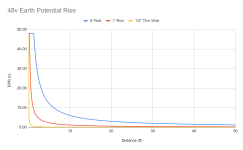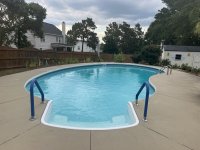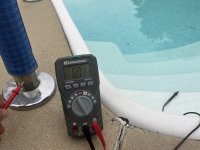- Nov 23, 2014
- 213
- Pool Size
- 16000
- Surface
- Plaster
- Chlorine
- Salt Water Generator
- SWG Type
- Hayward Aqua Rite (T-15)
Seems like this bond test is very key, when weather permits.He did say he thought it might have a broken bond. From what he said, this seems to be his main thought. He tried several tests with a bond wire (his own) and my pool and handrails. It was 101 degrees here so we were all about to pass out.
When you measured 4.5v to each rail, was that between each rail and nearby water? Or between the two rails? Always need to know the two points at which measurement was made. Whatever you wind up concluding about the source, it seems impossible to me that a potential difference (ie defined as voltage) exists between rail and water - or between rails for that matter - if the rails and water are truly bonded together.
Revisiting the source (which per above I still think is rather moot): You say it must be coming from the house panel, but have you run Mike Holt's tests, such as the resistance of the ECG from the pump back to the panel? Can only be done, as he states, with bonding wire and ECG disconnected at the pump. Have your guy do it if you're not comfortable with the pump wiring. Am trying to determine whether voltage is being induced onto the ECG (again that's the green ground wire) from your house wiring or from the power company. Another way to verify that is to run a new temporary ECG wire from the panel to the pump, temporarily replacing the present ECG to see if that changes things. If problem disappears, the ECG is suspect somewhere between the pump and the panel. It's simple enough for voltage to be induced onto the ECG as it travels from panel to pump - especially if there is high resistance in that ECG path - via a loose wire nut or unsecured screw to box, etc., anywhere in the path - and/or if that ECG travels a long path next to other active circuits sharing a conduit. In such a case your test results would also change from moment to moment, depending on the other circuit loads. Pop some toast in the toaster and suddenly you get a rail tingle. I spent a lot of my electronics engineering career - the boring part - analyzing and moving hundreds of circuit board paths to minimize parallel runs. I think you already proved that the problem persists even with all other home circuits disabled - such as with the main breaker off - so perhaps the parallel induction is unlikely. But the resistance of that ECG is still germane, and you can only get a valid test of it with other grounds and bonding disconnected.
Returning to the soapbox: Mike Holt's methodical test sequence is based on months of expert planning and experience by a team. If you wind up considering tearing up concrete before you've run through all the tests in his video, then I'll be siding with your wife about sanity










